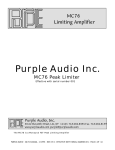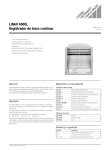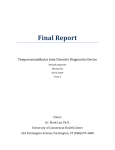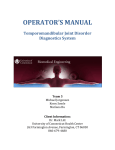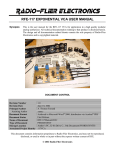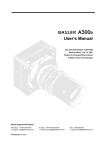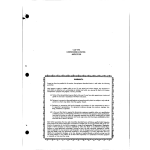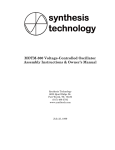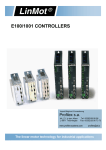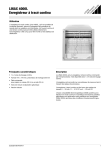Download MC77 Manual & Schematic
Transcript
MC77 Limiting Amplifier Effective with Serial Number 450 Operation and Service Manual Table of Contents 1 2 3 4 5 6 7 8 9 10 11 12 Description General Definitions Specifications - Electrical Specifications – General Front Panel Controls Back Panel Connections Unpacking and Installation Operating Instructions Maintenance Cleaning Repairs & Warranty News 13 Schematics 1. DESCRIPTION The MC77 replaces the MC76 re-engineered 1176 type FET Limiter After selling hundreds of the original MC76 units we incorporated new features based on user feedback. The MC77 is a gain limiting amplifier. Units of this type have been used for many years to provide precise and automatic control of peak signal levels in recording studios, disc mastering facilities, broadcast stations and sound reinforcement applications. Gain reduction in the MC77 is accomplished using a Field Effect Transistor (FET) as a voltage controlled variable resistor shunt. The FET is the first active component in the signal chain. Large amounts of limiting can occur without large increases in distortion. There are four compression ratios that can be used to best complement the program material and the specific application. Attack Time is continuously adjustable from less than 20microseconds to 800microseconds. The fast attack time response is independent of peak frequency content or duration. Over the audio band the full limiting action will stabilize in under a half cycle. Release time is continuously variable from 50msec to 1.1sec. Release time is defined as the time it takes for the gain to recover to within 63% of the normal non-limiting gain. Provisions have been made for the interconnection of two MC77 limiters for stereo operation. 2. GENERAL DEFINITIONS Compressors and Limiters are used in many applications. A technical application for these devices is when the dynamic range of program material is too large to be processed by succeeding equipment, when the peak-to-peak amplitude is too large for the headroom of the following equipment. Compressors and Limiters are used to reduce the dynamic range of the program material so it "fits" through the equipment and systems that follow. Good examples are broadcast transmitters and public address systems. A non-technical application is as a production or creative tool. Any device that changes dynamic range will cause some subjective change in the sound of the program material. Reducing the dynamic range of an individual track in a multi-track recording and making it more consistent makes it easier to control in the mixdown process. Its applications as a production tool are limitless. The two different terms (Compressors and Limiters) generally refer to the degree to which the dynamic range is reduced. The relationship of input level change to output level change is called the Compression Ratio. If, for example, an increase of 8 dB input signal level should cause the output to increase by 2 dB, this would represent a 4:1 compression ratio. Amplifiers with compression ratios of up to 8:1 are often considered to be Compressors, while those with ratios higher than 8:1 are called Limiters. The MC77 can function as a compressor or a limiter since it has compression ratios from 4:1 to 20:1. Signals at levels below the threshold will not be affected by the compression/limiting action. Any change in input level below threshold will result in a corresponding and equal change in output level while increases in input levels above the threshold will cause a controlled decrease in amplifier gain resulting in a reduced increase in the output level in proportion to the compression ratio. The MC77 Input Level control adjusts the amount of signal to be processed above the threshold, and hence the degree of compression, or limiting. 3. SPECIFICATIONS - ELECTRICAL Note: the dB voltage level measurements listed here are referenced to 0.775 Volts RMS. We have seen dB measurements referenced to 0.775 Volts RMS labeled interchangeably as dBu or dBv (note the little "v") while dBV (a big "V") uses 1 volt as a zero reference... and to make things worse people still use the dBm scale to discuss voltage levels across what they are measuring.... A dBm level is a measurement of power that references to 1mW dissipated into a given load and is almost always measured indirectly as a voltage developed across a known load of 600 ohms. If someone tells us they are measuring +4dBm at the input terminals of a device with a 10K ohm input impedance what are we to think? We prefer the dBu scale because we are measuring voltages. Oftentimes, we are not measuring across a 600 ohm "line" AND later when we read these specifications over the phone we don't have to keep saying "dB little v" Input: Constant Impedance Input Attenuator Transformer Balanced and Floating Input Impedance: 600 ohms at all input gain settings Maximum Input Level: +30dBu with limiting active and input cranked up full (Prolonged exposure to signal levels in excess of +30dBu may burn up the input attenuator) Maximum Gain: 45dB ±1dB (with limit action switched off) Frequency Response: 15Hz to 80KHz ±1dB typical Output: Floating Transformer Balanced Output Load: 150 ohms or higher Load Dependence: The Output Level as measured while driving into a bridging load will drop by no more than 1/2 dB when a load of 600 ohms is added there will be a loss in headroom Maximum Output Level: +24 dBm into 600 ohm load (12-1/4 volts RMS) +30 dBu into bridging load (24-1/2 volts RMS) SPECIFICATIONS - ELECTRICAL - continued Distortion: Less than 0.5% THD+noise 22Hz-22KHz with limiting activeRelease time set to 1.1sec (fast release times will increase distortion at low frequencies) - NOTE: The VU meter is now buffered from the audio and adds no appreciable distortion. S/N Ratio: >81dB at threshold of limiting 22Hz - 22KHz unweighted Attack Time: Less than 20µsec for full limiting action adjustable to 800µsec with front panel control Release Time: Minimum 50msec adjustable to 1.1sec maximum (for 63% recovery) with front panel control Threshold and Ratio: With the input control fully clockwise and the output gain control set 10dB below maximum (at about 6 on the dial) The overall gain (before limiting) should be 35dB (±1dB) The threshold of limiting is defined here as 1dB of limiting at 20:1 the threshold of limiting will occur with an input of -24dBu (±2dB) and yield an output level of +10dBu at 12:1 the threshold of limiting will occur with an input of -25dBu (±2dB) and yield an output level of +9dBu at 8:1 the threshold of limiting will occur with an input of -26dBu (±2dB) and yield an output level of +8dBu at 4:1 the threshold of limiting will occur with an input of -30dBu (±2dB) and yield an output level of +7dBu Note: lower ratios make the limiting action kick in sooner SPECIFICATIONS - ELECTRICAL - continued Power Requirements: 100-125 Volts AC or 200-250 Volts AC selectable At 115 Volts the current draw is 1/2 mA (typical) and the unit should be fused for 1/8 Amps At 230 Volts the current draw is 1/4 mA (typical) and the unit should be fused for 1/16 Amps Line Frequency can be 50-60Hz Temperature: The MC77 can operate safely over a temperature range of 0°C to +50°C The MC77 can be stored over a temperature range of -20°C to +60°C 4. SPECIFICATIONS - GENERAL Dimensions: 2U 19" rack mounting enclosure (19" wide 3-1/2" high) Depth behind front panel is 8" (not including connectors) Finish: Front Panel is 1/8" thick aluminium purple anodized with some variation in color - this can be viewed as a feature and lends a certain individuality to each unit - Case finish is black powder coat. Legends are silk screened in white. Weight: 12 pounds – loose, 15 pounds – shipping weight. 5. DESCRIPTION OF FRONT PANEL CONTROLS Input Level Control: Continuously adjustable rotary attenuator Output Level Control: Continuously adjustable rotary potentiometer Attack Time: Continuously adjustable rotary potentiometer Ranges from the slowest attack time of 800 microseconds to the fastest attack time of 20microseconds at the full clockwise rotation Limiting In/Out: The Attack Time control has a switch position at its full counter-clockwise rotation. This turns limiting action off Release Time: Continuously adjustable rotary potentiometer Ranges from the slowest release time of 1.1sec to the fastest release time of 50msec at the full clockwise rotation Insert: Engage for Insert/Key input mode. Side Chain Insert Loop Switch places a differentially balanced send and return into the normal connection from the top of the output pot to the side chain detector and gain control circuitry. This loop allows EQ, filters and other external processors to be used to modify how the limiter responds i.e. as a vocal stressor or with a low cut filter to limit bass and improve its definition. This insert is always sending, return is bypassed until activated. Link: Engage for stereo mode. New Stereo Link Circuit sums the audio feeding the control circuitry of a pair of MC77 limiters instead of simply joining the FET busses. This eliminates the need for alignment and the additive effect of attack and release times. Linked Stereo limiting is now plug and play and the limiting action is now just as fast as in an unlinked monaural MC76 or MC77. Compression Ratio: Four Position Interlocked Push-button Switch allows selection of 4:1, 8:1, 12:1 and 20:1 compression ratios. Some users enjoy pushing more than one of these buttons at once. Meter Function: The VU meter is switchable between I/O level and Gain Reduction. Top switch In position is for monitoring Gain Reduction, Out for monitoring I/O level. Second switch In for Input level, Out for Output Level, Both referenced at +4dBu. *Note Input level is monitored across the 600 Ohm input. You may notice a level drop depending on source. This is normal loading and not a metering error Bypass: The third switch is for system bypass, this connects the input directly to the output so the user can quick A/B limiter in vs limiter out. Unit defaults to bypass when the powered off. Power Switch: The bottom switch is marked ON. Gain Reduction "0" Adjust: Screwdriver accessible adjustment via small hole in front panel between input and output level controls 6. BACK PANEL CONNECTIONS XLR Pin Assignments: PIN 1 = Chassis, Earth, Ground PIN 2 = Signal "Hot", Positive, ø+ PIN 3 = Signal "Cold", Negative, ø- Wiring systems vary from facility to facility. PIN 1 may or may not be used to terminate a shield or drain wire. In general this pin and the shield or drain wires connected to it are not to be used to “Ground” or “Earth” the unit. Shields and Drain Wires should NOT carry current and are generally connected at only one end of any given wire. For your convenience and to assure that the chassis can be easily grounded (earthed) there is a Chassis Ground Lug on the back of the unit and the center pin of the IEC power inlet is connected to the chassis as well. PINS 2&3 of the input and output XLR connectors must be connected to get signal in and out of the unit. Since the inputs and outputs are transformer balanced there is no problem unbalancing either the input, the output or both. Because the input attenuator ahead of the input transformer takes PIN 3 of the input XLR to signal common is the preferred way to unbalance the input. To maintain consistent phase from input to output connection of PIN 3 to audio common is the preferred way to unbalance the output unless you WANT to flip the phase. Input & Output XLR: Standard connections - Transformer isolating. Insert Send & Return XLR: a differentially balanced send and return into the normal connection from the top of the output pot to the side chain detector and gain control circuitry. This loop allows EQ, filters and other external processors to be used to modify how the limiter responds i.e. as a vocal stressor or with a low cut filter to limit bass and improve its definition. This insert is always sending return is bypassed until activated. Stereo Interconnection: Two 1/4" Jacks marked Link, Input and Output are used to connect two units together for stereo mode utilizing the link control on the front panel. Using two 1/4” TS or TRS cables connect the Out jack on each unit to the In Jack on the other unit. IEC Power Inlet: Accepts standard IEC type power cable and includes: Fuse Holder - see back panel markings for fuse rating Audio & Chassis Ground: Audio ground is connected to the audio circuit, Chassis ground is connected directly to the steel case and the IEC ground. These are shipped from the factory linked, leave these linked unless you have a reason to separated your audio and chassis grounds. If you do separate them leave the link on one of the lugs, otherwise you will lose it. 7. UNPACKING AND INSTALLATION Your MC77 was packed with care at the factory. The packaging was designed to protect the unit from rough handling. However, once the unit leaves us, it may pass through the hands of those who have no idea what is in the box, may not be happy with their job, or may like to throw things. Despite the heavy duty carton and foam blocks the unit was packed with, we recommend you inspect the box and its contents immediately for any sign of damage that may have occurred in transit. If there is damage, you should save all the packing materials and contact your vendor immediately. We recommend you keep the packing materials. Murphy’s law states that once you throw away the box the likelihood you will need it back will increase in proportion to the square of the distance from your service center multiplied by the cost of replacement packing materials. The carton we ship out contains: *One MC77 Limiting Amplifier *This Manual *One six foot (two meters) IEC Cable *Warranty Card 8. OPERATING INSTRUCTIONS Start with all controls at mid–rotation. Insert Out, Link Out, Ratio 8, Meter GR with Bypass out. Adjust input to show some gain reductions. Switch Meter to I/O, OUT. Adjust Output level for levels around 0 VU. The Attack Time of the MC77 is the time it takes for the detector circuitry and FET to respond to a signal as it exceeds the threshold. This parameter is variable by the user since the adjustment may have a significant effect on the sound of the program material. The Release Time may be defined as the time it takes the limiter to return to its normal gain, after the signal which has caused the gain reduction has dropped below the threshold. The release time is variable for the same reason that Attack time is and can substantially alter the sound of the program material passing through the MC77. Together, Attack and Release times will define much of the sound or coloration in any given application. For the dirtiest sound push in all four Ratio buttons, attack counter- clockwise, but not off, Release clockwise. For Bypass Mode Push in Bypass Button. Insert places a differentially balanced send and return into the normal connection from the top of the output pot to the side chain detector and gain control circuitry. This loop allows EQ, filters and other external processors to be used to modify how the limiter responds i.e. as a vocal stressor or with a low cut filter to limit bass and improve its definition. This insert is always sending, return is bypassed until activated. Link connects input of the compression amplifier to the output of the Link summing amplifier. Link out is a buffered output that is also run into the summing amplifier with the Link In signal. This summed output is then run into the compression amplifier. 9. MAINTENANCE METER ZERO ADJUST (Allow 15 minutes warm-up) Push the "GR" meter function switch. The VU meter should read "0" on the VU scale since the limiting function is disabled (the attack control knob is turned to OFF). If the "0" indication has drifted beyond + or - 1 dB with no signal, it should be adjusted. This may be done through the hole in the front panel located between the Input and Output level controls using a small screwdriver. The trim pot is straight back through this access hole and requires a small slotted screwdriver. INTERNAL SERVICE ADJUSTMENTS These controls have been set at the factory and should not require adjustments except after service work. If re-calibration is necessary, the test procedure that follows should be performed very carefully, and adjustments performed in the exact manner and order specified. Before attempting any calibrations, the limiter should be on for at least 15 minutes. This avoids subsequent drift. WARNING: The full AC line voltage is present at several points inside the chassis. Be careful to avoid personal shock when you work with the MC77 with the covers removed. At worst you can be killed and at the very least it will make you unhappy. POWER SUPPLY The positive DC voltage should be +30 volts (+or- .5) the test point to measure the level is top trace end of R51. The negative DC voltage should be -10 volt (+- .5) the test point to measure the level is the right hand end of R90. "Q" BIAS ADJUSTMENT - (R59, internal trimpot) This is a very important parameter to assure the linear operation of the limiter. Therefore the adjustment should be performed very carefully. Set the controls as follows: Input = "24" mid rotation Output = "24" mid rotation Attack = full CCW (switched to off position) Release = full CW Compression ratio = 20:1 Meter mode = "GR" Q-bias adjustment = full CCW MAINTENANCE - continued Apply a signal (1 KHz, O dB) to the input, and adjust the output to read +11db as read on an external meter. Slowly turn the Q-bias adjust (R59) CW until a drop of 1 dB occurs, and the external meter reads +10db. This places the gain reduction FET Q1 slightly into conduction. GAIN REDUCTION METER TRACKING - (R75, internal trimpot) Due to interaction of the adjustments, this procedure may have to be repeated to achieve satisfactory tracking. Setup: No signal Disconnect R44 Voltmeter across R74 Calibration 1. 2. 3. 4. Zero MC77 "GR" meter with R71 (Thru front Panel Zero Adjust) Adjust pot R75 for 0.0 Volts across R74. Repeat 1 & 2 until both conditions are met. Set controls as follows: Input = "24" mid rotation Output = "24" mid rotation Attack = full CW Release = full CW Compression ratio = 20:1 Meter mode = "GR" 5. Apply a signal (1 KHz, 0db). 6 Set output control for 0db as read on an external meter. 7. Set attack full CCW (off position). Set input control for +10db as read on an external meter. 8. Turn the attack control OFF (CCW) and readjust the output level control for "0" if necessary. 9. Repeat 7 & 8 until the output drops 10dB whenever the attack control is turned ON. 10. Reconnect R44. MAINTENANCE - continued SIGNAL PREAMP LINEARITY This control (R86) is in the feedback loop of the amplifier and affects the operation of Q1. It will never be necessary to perform any adjustment of R86 unless resistors in this section of the circuit have been replaced. If adjustment is required, set the controls as follows: Input = Full CW Output = to number "18" on the front panel Attack = full CCW (switched to off position Release = Full CW Compression Ratio = 20:1 Meter mode = "GR" Apply an input signal (500 Hz, -30 dB) and measure THD of the resulting output signal. Adjust R86 until the minimum amount of distortion is achieved. 10. CLEANING THE LIMITER The front panel of the MC77 may be cleaned with a non abrasive cleanser such as Formula 409, or "Fantastic" applied with a soft clean cloth. Additional protection of the anodized panel can be afforded through a light application of a spray wax preparation such as Pledge. NOTE: NEVER SPRAY THE PANEL DIRECTLY AS THE CLEANSER OR WAX MAY ADVERSELY AFFECT CONTROLS OR METER, AND CAN CONTAMINATE CIRCUIT BOARDS IF IT PENETRATES THE CHASSIS. 11. REPAIRS AND WARRANTY *We will service and repair the unit free of charge for three years from the date it is shipped. We track warranty by serial number therefore make sure to leave the serial number tag on the unit. We will not repair damage that results from misuse, abuse or neglect. We do not guarantee that the purple color of every unit will match the purple of every other unit. Should a malfunction occur, please email the service department at [email protected]. You will receive instructions for return. Be sure it is well packed in a sturdy carton with shock absorbing material. Tape a note to the top of the unit describing the malfunction and instructions for return. We will pay one-way return shipping cost on any in-warranty repair. Because of specially selected components in this product, field repairs are not authorized during the warranty period. Attempts to perform repairs may invalidate the warranty. Even if your unit is out of warranty, we recommend that you return it to the factory for repairs. Our experienced personnel, supported by special test equipment, will be able to find and eliminate any problem in the most efficient way. 12. NEWS For current information about Purple Audio visit our website at: “http//www.purpleaudio.com”. PRE-AMP OUTPUT AMP meter buffer +30V J2 R14 22K 2 DECK POT IN EARLY UNITS C4 100uf/25v R1A IN HIGH R3 R2 + C815 .1uf R9 R2 & R3 620Ω 1/4W T1 R1B UTC 0-12 or Equivalent 1 2 3 4 IN LOW R1A Front deck & R1B rear deck R4 270 Q1 2N5457 6 7 8 500Ω: 200Ω R18 180 R85 150 R1A R6 2M2 C9 .22 C22 .22 R1B R7 2M2 5K Z Tap IN LOW R12 910 C5 100uf/25v R21 56K 1/4W Ratio PCB R19 R78 R20 56K 1/4W 68K 1/4W 56K 1/4W Pin 2 + OUT HI XLR F P2 Relay RL1 W/ IN4003 D43 C12 R30 200K 100uf/25v R27 1K5 + CR1 IN4148 C818 .1uf C14 .033 WHITEBLACK GREY WHITERED VIOLET C13 270pf R31 10K RED NO Pin 3 - DS2 AROMAT JUMPER J1 C819 .1uf C601 100uf/25v XLR M P3 3 NC XLR F P3 Bypass relay controlled by bypass on meter switch assembly Power Off/ Bypass R32 39 +30V Jumper TO LINK CIRCUIT (T&C) R88 10K FROM LINK CIRCUIT Top R61 470 1/4W W/IN4003 D40 20:1 4:1 1 +30V @50ma Ripple = .25mv with load "In" Link Relay 12:1 R28 27K INSERT LOOP DRIVE Aromat TQ2E RL 3 8:1 NC BLUE BLACK Q5 2N5088 W/IN4003 D41 INSERT RETURN R1A FRONT, R1B MIDDLE, R1C REAR 4:1 3 Meter buffer Q6 2N3053 Loop Relay Distortion Adj R22 47K 1/4W 500Ω Lin XLR M P2 NO Aromat TQ2E RL4 R86 100 J3* R1C R25 2M7 JUMPER C15 .0047 BROWN Q4 2N3391A .15 R23 250K 2W Output F.P. Audio Taper + R29 1M2 R15 6K8 C3 200pf C6 200pf 17 15 C7 1uf/50v R11 82 R84 180 500Ω Lin 100uf/25v R24 2M7 C8 R33 560 R34 8K2 C11 10pf C10 1uf/50v C816 .1uf C600 Q3 2N3391A C2 27pf C28 100uf /25V R10 10K BOTTOM 3 DECK POT IN LATER UNITS IN HIGH C817 .1uf + 5 C1 1uf R5 27K Q14 2N3391A Q2 2N3391A R8 560K 1K R26 68K + TOP 6K8 R17 + R13 1M 600 Ohm "T" Attenuator 12:1 8:1 2 R62 R63 560 1/4W 1K5 1/4W R45 Q22 MPS3569 C820 .1uf 3 R87 200R CR15 24V IN5252B 20:1 10M 1/4W 28 Orange w/IN4003 D42 NO 3 + 2M7 R37 470K Null Test Q13 2N5088 R44 (T&C) ~1K 10K R66 R72 1K5 Q7 2N5088 R40 2K4 R39 4K7 R41 270 R73 R71 680 2K 14 12 "0" Set F.P. 13 METER DRIVER R47 44K2 R42 180K R43 38K3 R48 7K68 CR28 Shunt Zener R49 2K4 R52 47K R53 47K C20 10uf/35v * J 1-6 30v/10w ECG5202A Attack Time Control F.P. Q10 2N5088 C19 10uf/35v R50 180 R75 2K Null Adj P.C.B. R76 8K2 R51 4K7 Q9 2N5088 R46 47K R69 1K5 R70 4K7 C18 100uf/50v + Q8 2N5088 C17 1uf/50v R74 R68 1K5 Jumper C814 .1uf R36 1M 23 29 Blue Q12 2N5088 J6* NC TO METER SWITCH R67 3K9 R38 47K C27 .022 R89 1K8 R54 470 C27 470uf/25v Red 19 R55 25K 1/2W CR2 FDH333 Violet 21 C813 .1uf FDH333 CR3 C21 100uf/25v R80 75 ohm 3W +30V R58 150Ω + 22 Aromat TQ2E RL5 Comp Off +30V 3 NC TO METER SWITCH Q11 2N5457 SIDECHAIN + NO +30V R79 15K R65 3M9 Power Switch Switch on attack For use w/out relay + Controlled by Switch on rear of Attack Release Control F.P. Blue 20 R64 1K5 1/4W R56 5M 1/2W R57 270K R59 2K Black 18 "Q" Bias Adj P.C.B. Bias for 1db attenuation + C812 .1uf R90 240 Vout -10V C810 .1uf Adj Vin LM3xx + + C809 .1uf + C811 .1uf BLUE C807.1uf -10V Ripple =.5mv with load CKC3001 Voltage Selector YELLOW ORANGE BLACK R81 CR7 1N4936Center tapped 100 1W 39.3vac x 2 R82 100 1 W WHITE BLUE C25 CR6 1N4936 C26 3300uf/35v C806 .1uf 3300uf/35v 41v DC/ .15A DC IEC LOAD FUSE 120V 1/8A SB / 240 1/16A SB Dual Winding 115VAC .2A / 230VAC .1A 23VA R35 10K R60 3K9 -10V Relays MC77 1/2 used to bypass relays 6/04 -10V CR41N4936 C805.1uf C23 GREY C24 3300uf/35v 3300uf/63v CR5 1N4936 + IEC NEUTRAL T3 C808 .1uf 09/02 Copyright © 1997 permission given to copy with proper acknowledgement. Purple Audio MC76 Drawn By ALR Date Drawn 7/97 + R402 33k2 PIN 3-OUT Aromat TQ2E RL2 W/IN4003 D44 + 6 R406 6 5 9 A401A Tl072 + 25 4 A401B tl072 R411 56K2 R415 3K65 C406 22uf/25v R414 120K + C201 22uf/25v R204 1K +30V +15V R203 100K 2 C202 22uf/25v 4 25K A201a TL072 +30V R205 25K 7 5 +15V R209 22R A201b TL072 R207 25K + 5 +15V 5 R302 3K9 1 6 10K R501 10K R503 10K 22uf/25v C310 + 3 8 1 2 - 6 4 R505 C501 22uf/25v LOOP RELAY BOTTOM A301B TL072 +30V R316 -2 INSERT RET+ P2 INSERT RET - P3 R314 10K + R317 R502 10K LINK RELAY BOT Voltage Divider +3 #7 POWER INLET 22uf/25v C203 + +30V 10K #5 PCB VOLTAGE SWITC Loop Return Amp 6 - 6 GR 29 BLUE +15V R206 25K 8 - Red GR 28 ORANGE RL 1 BYPASS GND R208 25K 1 R202 Blue OUT IN + 3 Pos IN #6 R412 100 C405 22uf/25v 8 7 6 - R310 120 R303 3K9 4 R504 10K C301 22uf/25v + R201 25K Neg #4 RL2 LEVEL GND LOOP RELAY WIPER Stereo Link OUT +30V C404 R408 .22uf 56K C403 120uf/16v + Meter switch For use without buffer R413 6K8 7 500 R409 9K8 C402 27uf/25v R402 56K 3 22 + PIN 2+ OUT 1 R401 33k2 C401 22uf/25v R401 56k 1K82 R410 23 External 3K6 J 4 Jumper OUT + + 2 PIN 2 + INPUT J 5 Jumper OUT - IN5229B Meter Buffer PIN 3 - INPUT CR402 CR401 R405 10k C304 470uf/16v INSERT SEND - P3 R311 10K R306 10K #1 A303 5532 + 5 C306 22uf/25v R315 10k - INSERT SEND + P2 +3 TL072 A301A R304 3K9 7 6 R309 10K R301 470 R305 3K9 1 + Insert loop driver TOP OF OUTPUT POT All relays close on gnd closure C305 22uf/25v -2 R308 120 4 C302 22uf/25v C303 470uf/16v R312 10K Jumpers MC77 + 2/2 R307 10K Copyright © 1997 permission given to copy with proper acknowledgement. 6/04 8/02 Purple Audio MC76 Drawn By ALR 7/97















